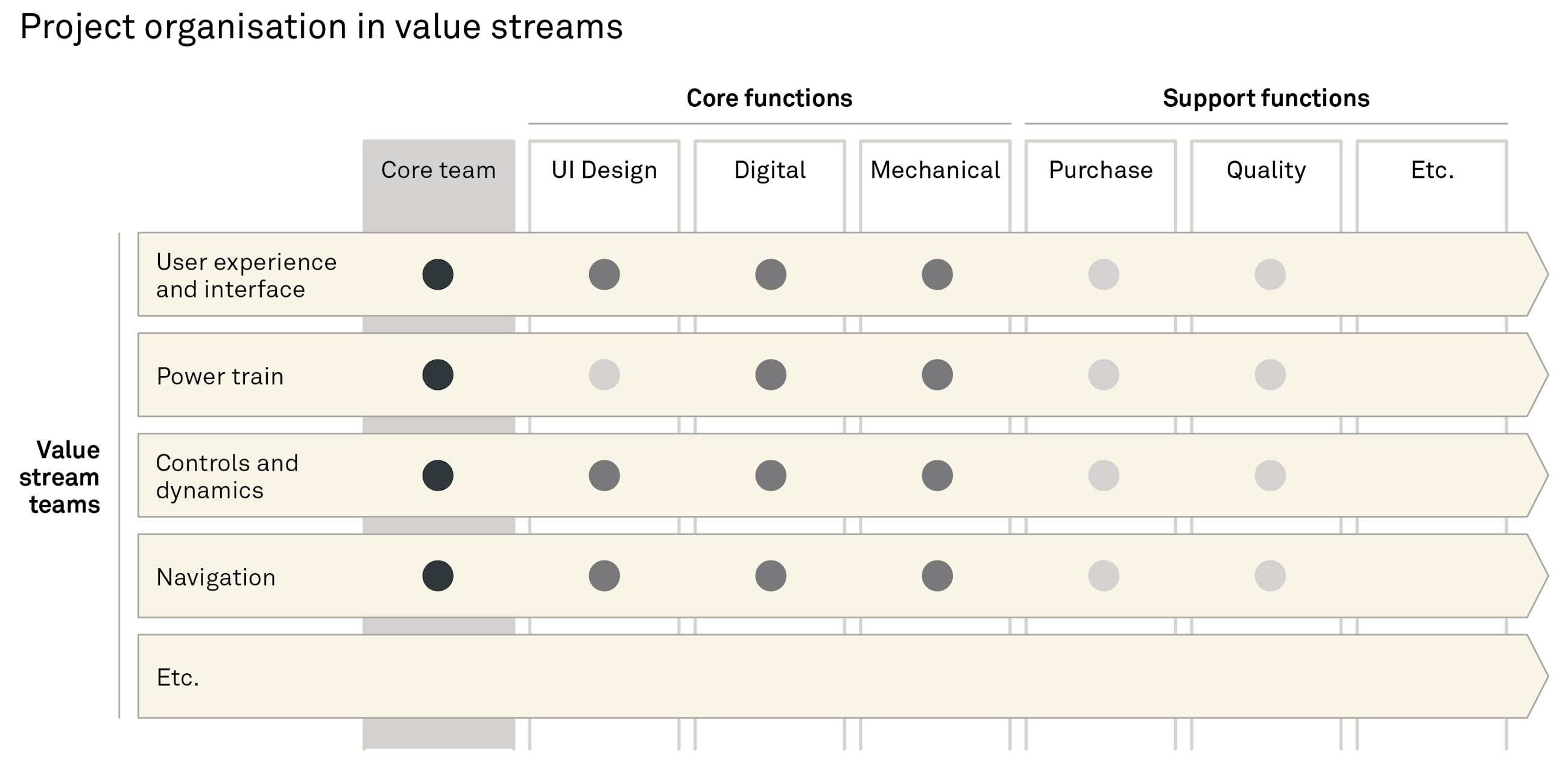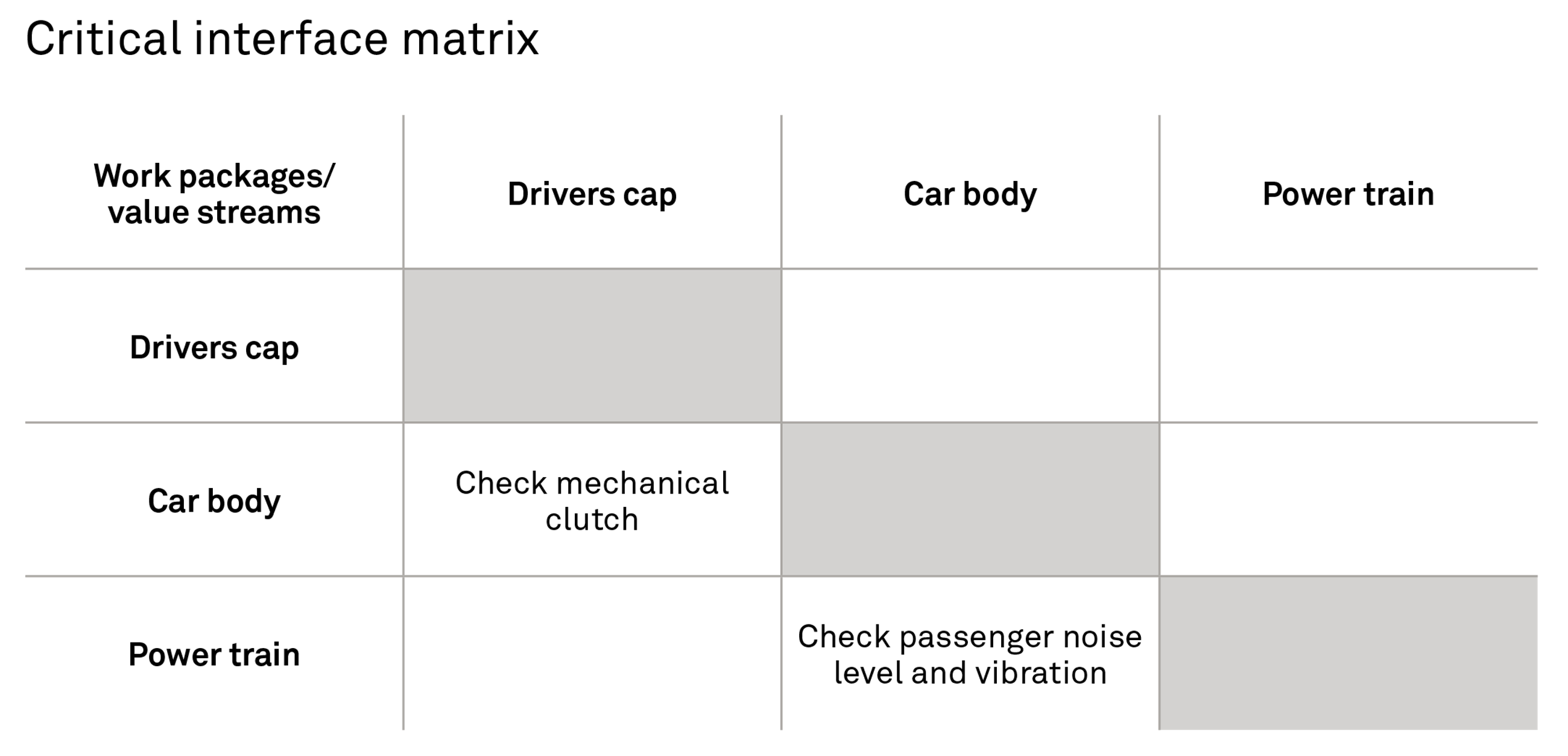Article
Accelerating project and solution delivery
Published
16 January 2025
In today’s fast-paced and volatile world, continuous renewal and development are the only way to stay relevant.
The development and launch of new solutions through programmes, projects, or product teams happen in many areas of the business; development of new products, release of new digital features, design and build of a new factory, implementation of a new CRM system, or rolling out a new strategy.
To consistently deliver faster and better than the competition will likely require changes in leadership style, core processes, enterprise/solution architecture, and organisational structures. But we believe it is essential to first dive into the key value-creating entity – the project or product team – to create an indisputable demonstrator of potential future impact. A demonstrator that speaks louder than words – and PowerPoint slides.
Why is lead time reduction important?
- Reducing project and release lead time offers substantial advantages, including:
- Faster cash flow: Earlier availability of income for reinvestment in new projects and growth of up to 50%.
- Increased capacity: Less idle time, confusion, waste, and task switching, increasing development capacity by up to 30%.
- Increased competitive edge: Faster response to user needs and market demands, capturing market share before your competitors.
- Improved employee satisfaction and performance: Streamlining project timelines and reducing unnecessary delays keeps teams motivated and engaged, improving performance.
- Accelerated learning and technological advancement: Faster project cycles mean more frequent iterations and feedback loops, driving continuous learning and innovation.
- Reduced obsolescence: Completing your projects while the ideas and technologies are still relevant. Timely action prevents the risk of launching obsolete features or products.
- Less time equals less cost: It is a law of nature. If things take longer, there will always be more complexity, more free-wheeling, more idling, and more waste – in other words, more unnecessary costs.
+50% project lead time reduction
demonstrated in projects/releases following the majority of our toolkit recommendations.
What are the root causes of delayed projects?
Completing projects on time helps you stay competitive and drive financial success. However, six underlying issues often cause major delays:
Overengineered solutions: Overly complex designs and project execution, making it harder for team members to understand the scope.
Lack of focus on fast value releases: Especially at the beginning of projects, the urgency to release user value is often lacking and is deemed something someone else will handle later.
Inefficient project management: Time wasted due to poor organisation and unproductive meetings without a clear purpose or outcome.
Handovers: Frequent shifts of responsibility are one of the key waste creators in many organisations today.
Low focus and engagement: Project teams with no clear goals leave project members less engaged and less productive.
Poor collaboration with externals: Communication gaps, delayed deliverables, quality issues, and increased risks due to dependencies on external parties (e.g. suppliers).
These six issues should be targeted to significantly reduce project lead times and create value for your entire company. At Implement Consulting Group, we specialise in identifying and tackling these types of issues, ensuring that your projects are delivered both efficiently and effectively.
Over the past 20 years, we have helped more than 300 companies transform and reduce lead times. Based on our experience, we have identified nine solution hacks that will help your projects excel and become world-class. Even if you only achieve some of these areas, it can put you ahead of the competition.
Are you ready to embark on this transformative journey?
Each week the product release is delayed, we lose EUR 1 million.
Project Vice President of a large pharmaceutical company
9 hacks to radically reduce lead time in your projects and product releases
- Define the vision, set targets, and drive accountability
Establish a simple and strong vision, set measurable targets, and ensure team accountability for the end-to-end process. - Build cross-functional teams that walk the extra mile
Build teams with diverse skills and a shared ambition for excellence with representatives from across the organisation. - Co-locate project teams to strengthen collaboration
Bring teams together in a physical (or virtual) working environment to improve focus, collaboration, and communication. Teams will be faster at problem-solving and decision-making. - Implement a consistent meeting system to increase productivity
Improve the time spent together in meetings by designing a meeting system where the right people have the right information at the right time. This ensures better alignment and efficiency, and the system maintains project momentum. - Develop standard modules to increase speed and customer value
Apply reuse and standardisation in design and processes. A modular approach speeds up the development of current projects and creates efficiency for future projects. - Build an MVP* road map and release plan to accelerate impact
A great source of time and cost savings is understanding what essential customer needs are. Use MVP staging to establish a roadmap with sequential value releases and impact validation. - Focus on “killer issues” with assumption-based testing
Save time by focusing only on the most critical issues in the project by using assumption-based testing, especially for projects with high technical or commercial uncertainty. - Demonstrate impact frequently to continuously improve the solution
Frequently demonstrate expected functionality of the future solution to users and internal stakeholders to discover what will work and how to further improve. - Integrate AI to increase productivity and speed
Use AI as an enabler to boost the overall impact and speed of your project. AI can automate administrative tasks, improve team communication, help generate design options, and test solutions.
Hack #1 Define the vision, set targets and drive accountability
Define the project ambition and start off strong
An inspiring and ambitious vision is essential for any positive change. Make it clear why the project is necessary and what the project aims to achieve, ensuring that every team member is fully invested in the overall vision. Break down the project’s objectives into specific and measurable goals that align with the broader organisational strategy. Outline the focus of the project and set the boundaries within the set time frame. Kick off the project with a bang to onboard all team members and create energy for the project ahead.
Illustrate and measure impact
The real value of projects comes from the impact they deliver which must be measured to ensure success. Once the vision is established, measurable and specific, targets need to be determined to track progress against the set objectives. Furthermore, the targets should track what actually results from the success of the project, such as reduced lead time and improved quality.
As projects often expand to fill all available time,1 use ambitious targets and stick to them at all times. The team can set end targets to measure success as well as incremental targets for each phase to make the targets more manageable. While the overall vision comes from top leaders, make sure to involve the whole team in setting targets and developing solutions. That is how the team becomes engaged and ready to walk the extra mile (see hack #2).
Optimise the end-to-end process
Organise projects around value streams with a focus on user outcomes. This ensures that team members have end-to-end responsibility, ownership of the solution, and a clear connection to the value that they are working towards. The bigger the project, the more important it is. Organising around value streams creates a direct link and feedback loop from daily engineering tasks to user value.
Team members are more engaged when they have dedicated responsibilities. This leads to faster and more accurate decision-making. Include the support functions in the value streams instead of silos on the side. Improve collaboration and increase efficiency across the project.
Example of a project organised in value streams (instead of functional departments).
Hack #2 Build cross-functional teams that walk the extra mile
Create cross-functional teams from all critical disciplines
People are what make the difference in a project. Tools, structure, and the vision are enablers. Optimal collaboration and communication can happen when cross-functional teams come together (for example, engineering, design, manufacturing, and logistics, depending on the project). The different perspectives that these team members bring help the whole team identify, address, and solve issues faster, reducing overall lead time. Encourage each team member to identify opportunities for optimisation and innovation. Furthermore, regularly review and optimise processes to drive efficiency.
Build small teams of no more than nine people
Trust, communication, and motivation are typically stronger in small project teams. Form teams with no more than nine members (and preferably smaller) while making sure that critical knowledge is well represented. For large projects, split and structure them into smaller end-to-end teams, following the product solution architecture. To maximise focus and speed, each team member should be allocated at least 50% and preferably 100% of their available time. This way, task-shifting waste is significantly reduced.
Team checklist
- A project manager/team captain who drives the value stream at the top level
- End-to-end value responsibility for delivering the working solution, incl. manufacturing and delivery system • A cross-functional setup that cuts across functional silos
- Team members with their primary loyalty to the project (i.e. the paying customer), and not their function
- or department
- >50% allocation of each team member to the project
Stimulate a culture of collaboration and excellence
Encourage a team culture where open communication, cross-functional collaboration, and a strong team spirit are key elements. Only by making a real commitment and acting as team players can the team reach its objectives on time. Provide space for continuous feedback throughout the project, encouraging rapid learning and improvement. With rapid learning and embedded improvements, the team can walk the extra mile. Incorporate best practices and lessons learned from previous projects or other teams, inside or outside the company.
Hack #3 Co-locate project teams to strengthen collaboration
Strive for co-location and a collaborative team space
Countless studies show that physical co-location of project teams significantly increases performance. Trust, engagement, communication, and collaboration are greatly improved when team members are co-located. When team members have a dedicated physical project space to co-locate to, project speed increases significantly, and communication becomes less complex. Ideas and issues can be shared and discussed in seconds, and decisions are made much faster.
In situations where being in a physical setting is not possible, simulate the environment as much as possible. Use online tools and platforms2 to create a virtual workspace where team members can collaborate and enjoy seamless communication and coordination.
Use visuals to increase insights and improve teamwork
Projects can be complex, and visual tools make them more tangible and engaging. Create visual plans or prototypes to clarify goals and actively involve the team. Whether you use a physical “war room” or a digital workspace, decorating the environment with relevant visuals can transform abstract ideas into actionable insights and inspire the team. Such a setup also signals to other users and stakeholders that their needs are a priority.
There is no one-size-fits-all solution. Encourage the project teams to design their own optimal collaboration spaces. Whatever they need to be at their best …
Hack #4 Implement a consistent meeting system to increase productivity
Set a meeting system for effective project collaboration
The purpose of project meetings is to provide an opportunity to share information and make decisions. With limited time and other resources, the project manager’s main goal is to ensure that meetings are effective. To get the most value out of the meeting structure, establish a consistent cadence that ensures that the right information and the right people are present at the right time.
Use a sprint structure to ensure a good project pace instead of organising in one long stretch. In addition, sprints ensure that the project workflow has momentum and that the project is broken down into smaller, manageable tasks. The team is more adaptive and can continuously refine based on the most current feedback and new insights.
Facilitate engaging and productive meetings
The project manager plays a crucial role in leading and facilitating effective meetings. Prepare time-boxed agendas and actively facilitate discussions to keep all stakeholders involved, focused, and engaged. The meeting formats should also be simple and consistent, with clear objectives so that everyone understands the purpose and process of the meeting. Maintain a positive ambiance to make the meetings engaging for all participants. E.g. to support team members with a highly technical background to improve their project management skills.
Tailor meetings to fit project needs
Each project is unique in terms of composition, approach, targets, etc., and therefore requires a customised approach to meeting design and cadence. The project manager should consider the specific focus of the project and ask the following questions:
“What is the focus of this project? “What needs should be prioritised?” and “What type of meetings will best support that focus?”
Customise your meeting types and structures to align with the project’s characteristics, ensuring that every touchpoint adds value and drives progress.
Example of a meeting system in a lead time reduction project for a global life science company.
Hack # 5 Develop standard modules to increase speed and customer value
The impact of standardisation and modularisation on development projects
The impact of using standardised and modular components and processes in new development projects can be split into three main categories:
- Time and cost: By utilising what already exists and has been developed, the need for resources is significantly reduced.
- Reliability and uncertainty: As the standardised modules are already in use, the uncertainty in terms of technical functionality and risks is significantly lower.
- Scalability and flexibility: Each new component or process developed can be used in multiple instances, leveraging the investment in each module and increasing flexibility in future development projects.
Rather than building something from scratch, imagine the improved efficiency of assembling already pre-defined Lego bricks. To significantly speed up development time and reduce the effort required, having an overall development strategy based on standardisation, modularity, and reuse is the right way to go. By using such a design philosophy, a long and complex project can be made much simpler if it is seen as a configuration of modules that already exist to some extent.
This, of course, also works the other way round, as each new project will develop additional modules that will add to the total and, in turn, assist future projects. However, to achieve this synergetic effect, a strategy and approach that maximises standardisation and the ability to reuse modules is necessary. This requires cross-functional communication and collaboration to ensure integrability and standardisation between different development projects. When functional silos dominate, there are very few benefits to modularisation.
An important note is that standardisation and modularity are not only applicable for products, components, and services but also to internal processes and workflows to speed up decision-making and execution, especially in a cross-divisional context.
Commercial benefits
In addition, there is significant customer value to be gained by using standardisation and modularisation in product development. More diverse customer requirements can be met by putting together a wide range of predefined modular pieces. Furthermore, if customer requirements change, modularity allows for adjustments even at the late stages of the development process or product life cycle.
Hact #6 Build an MVP road map and release plan to accelerate impact
MVP road map
A minimum viable product (MVP) is a version of a product under development that does not have all features embedded but just enough to make it useful for early user. Or, if it is a single user (made-to-order product), it starts utilising some initial features (e.g. certain production lines in a new factory). There are two main benefits of offering an MVP: 1) product development will result in earlier revenue streams, increasing positive cash flow and thus reducing project payback time; and 2) gathering ongoing user feedback on product requirements, ensuring a final delivery that is more likely to be competitive and fit user needs.
By focusing only on key user value, you can release faster. This is a clear advantage of MVP thinking. Additionally, making a few releases on the way to the bigger vision is an excellent way to de-risk strategy. In many cases, we have seen quality-conscious engineers eager to develop a generation 4 product, but by the time we reached generation 3, we had already captured enough of the market share.
Create and communicate a clear release plan
Internally, the release plan communicates to the organisation and affected stakeholders and departments who should do what and when. Investing a lot of effort in developing a rigid and coherent release plan makes it easier for the team to identify critical dependencies between features and bottlenecks in the development phases, which allows for proactive action and adjustments to the plan, thus minimising the risk of delays. It is important that the team behind the release plan is cross-functional, including everything from R&D and operations to sales and marketing. Develop the project plan with the end goal in mind. Break down deliverables into quarterly, monthly, and weekly milestones. Make sure that the entire core team collaborates on this topic to identify and address bottlenecks and issues together.
User feedback loop for the release plan and the MVP
Users themselves can play a pivotal role in reducing the lead time of complex projects. Clearly communicating the release plan externally can gather user input in terms of release timing, potential features, etc. Furthermore, offering an MVP to early users allows you to collect feedback both on already existing features that require additional engineering efforts and changes, and also on features that were promised in the final product, but most users may not need, resulting in a significant reduction in lead time and engineering resources required as certain features can be ignored.
MVPs are created and released that provide early impact even though they have few features.
Hack #7 Focus on “killer issues” with assumption-based testing
Many programmes and projects follow a standard project model or framework, such as PMI, PMP, or PRINCE2, which is strictly adhered to. However, projects are very different in nature. Some involve engineering well-known technology with well-known suppliers and contracts, while others require a much greater degree of new design due to a higher degree of technical and commercial uncertainty.
A structured but cost-effective approach to managing uncertainty is therefore needed – something suitable for all project model frameworks and types of projects. Due to the complexity of projects, the number of assumptions can become significant. Therefore, an approach is needed to work with and test the most critical ones.
Efficient and focused testing of key assumptions
Standardised project frameworks that have been tried and tested work really well and should, of course, be used when appropriate. But in projects or parts of projects where uncertainty is high, assumption-based testing is a powerful method. It helps prioritise testing and learning on topics of high impact and uncertainty (“Leap of Faith Assumptions”), while reducing efforts in areas of low uncertainty, as shown below.
Projects with high uncertainty solution deliverables
- For projects with a high degree of uncertainty, the following initiatives can be introduced:
- Encourage and motivate innovative outside-the-box and outside-in thinking
- Lead teams towards flexibility – project scope and plans are bound to change, and adjustments may occur frequently
- Use methods and tools from innovation or agile project paradigms, such as Design Thinking or Lean Startup methodology, to gain critical knowledge as early as possible in the project
- Use supplier contracts that stimulate collaboration and joint solution identification, for example, by incentivising suppliers to identify alternative solutions instead of simply aiming to deliver a solution that was initially conceived when there was very little knowledge and information available
- Adjust your regular meeting rhythm and agendas to include identifying, prioritising, and testing assumptions
Hack #8 Demonstrate impact frequently to continuously improve the solution
In many projects, the user may end up waiting months before seeing the final solution – or even parts of it. Even internal project team members may not see their colleagues’ work for long periods of time. As the final solution often needs to be slightly, or completely, different from what the front-end designers originally thought or communicated to the engineers, the lack of regular updates creates problems. In addition, one engineer’s solutions often depend on another engineer’s solutions. For example, the pipes need to fit a certain flange on a tank, and therefore all sizes need to be adjusted.
Don’t tell it. Show it!
Schedule demonstration and solution integration sessions with a fixed cadence, e.g. monthly. Demonstrate the product, solution, process, or the entire supply chain to selected people, such as the top project team, the business owner, the user, the manufacturer, maintenance crew, or other relevant stakeholders. The best demonstrations use a real-world prototype. If the end product is too complex or too big to demonstrate physically, showcase your solution using drawings, images, simulations, or 3D printing.
Demo sessions can also be used to test critical interfaces in a simple matrix. This can be done by having a matrix poster available in the (physical or virtual) demo room and asking participants for their feedback on potential interfaces after each demo.
Motivate your engineers and users
Demo sessions infuse a lot of motivation and engagement into projects, allowing engineers to showcase their work and users to see and feel the progress of the project. They allow everyone to get a clear and unified view of the solution while igniting conversations and providing space for key questions and knowledge sharing early in the project, when there is still time to react.
Commit the entire team to using available software/tools
When running a complex and long development project, there is sometimes a lack of internal transparency and overview for the team(s) involved. To overcome this issue, available project management tools should be utilised to a large extent, enabling the people involved to see progress and tasks, and to facilitate internal communication. This ensures greater visibility and control over project timelines and helps identify and address delays immediately.
Hack #9 Integrate AI to increase productivity and speed
How can you use AI in your projects?
AI has been a part of our lives for decades. Over the past few years, the use of AI has skyrocketed, and it is becoming increasingly integrated into our lives. AI is changing the business landscape and revolutionising how companies work at all levels. 91% of executives see generative AI as a big opportunity for their organisation, and 42% of employees use generative AI tools several times a week.
In complex projects, the integration of AI offers significant benefits when used effectively. On average, AI can increase productivity by 32% and quality by 18%.3 The following four use cases show where AI can increase productivity and speed in your projects.
1. Empower the project manager
Seeing as a large part of project managers’ time is spent on administrative tasks, AI can be used to automate or significantly speed up things like agenda preparation, meeting summaries, and resource planning. The time freed up can be better spent focusing on the actual progress, engagement, and impact of the project.
2. Enhance cross-functional communication
Complex and cross-functional projects often involve multiple divisions and specialised teams, introducing a multitude of technical definitions and jargon that is difficult for everyone to understand. AI is an excellent tool to help summarise complicated solutions or track compliance with standards.
3. Improve solution generation and iteration in technical design
AI can greatly increase the impact for the customer in many ways. For example, it can help project managers and engineering teams generate and test ideas at a much faster pace. Concrete examples include AI helping with creating blueprints and complex AutoCAD designs. Furthermore, AI can be used for predictive analytics and risk mitigation to provide insights into when maintenance, replacements, etc. should happen.
4. Include user feedback and the AI “stakeholder”
Looking ahead, AI will revolutionise customer interactions and feedback by acting as a virtual “stakeholder” in project discussions and specifications. Equipped with deep knowledge of the customer’s market, internal capabilities, and strategic goals, AI can streamline decision-making processes regarding technical specifications and deliverables. This application not only accelerates project timelines but also enhances the precision and relevance of the outcomes.
AI already has a significant impact on how projects are run and executed. Staying competitive requires an openminded approach and a willingness to experiment. Embracing AI and using it to your advantage can lead to a significant reduction in project lead times, fundamentally changing the way projects are managed and delivered.
Notes
1 Parkinson’s law, Atlassian (2022)
2 Such as Teams, Miro, Mural and Trello. (s. 8)
3 Implement Consulting Group 2023 survey.
Contact0 6
0
6Let us work together to radically reduce the lead time of your projects and set a new benchmark in your industry!
Related0 4
Article
Read more
How to embed customer centricity in your company
A combination of top-down commitment and bottom-up activation.Article
Read more












